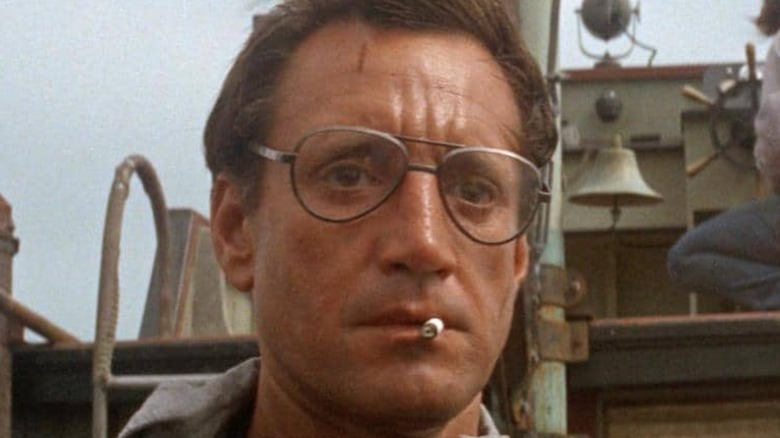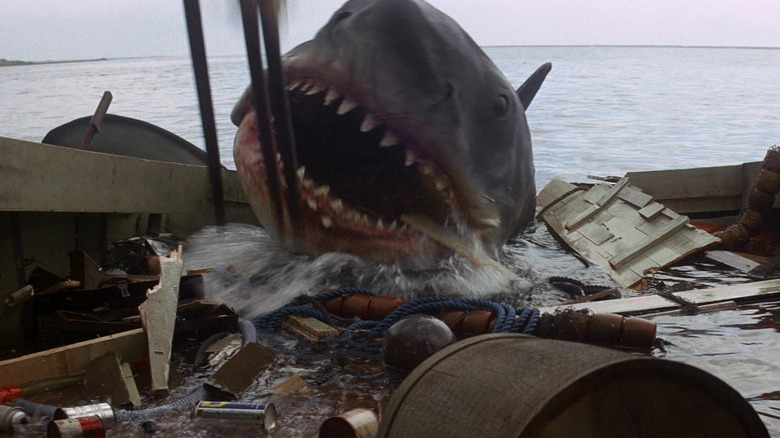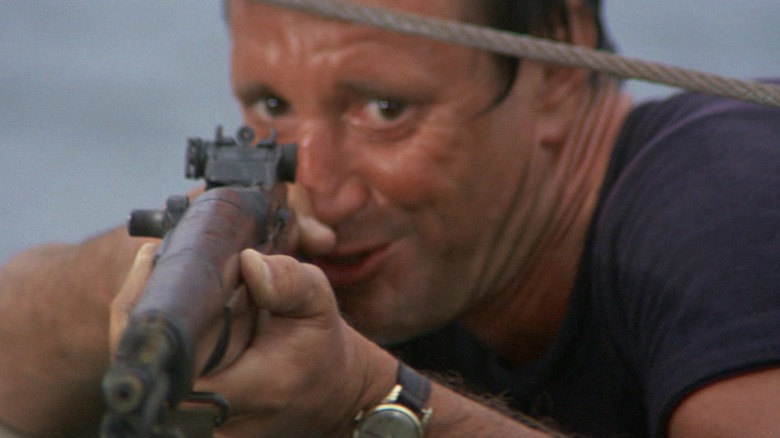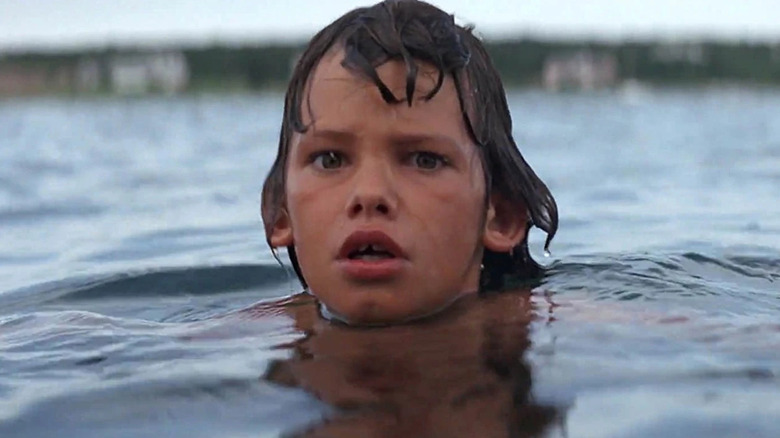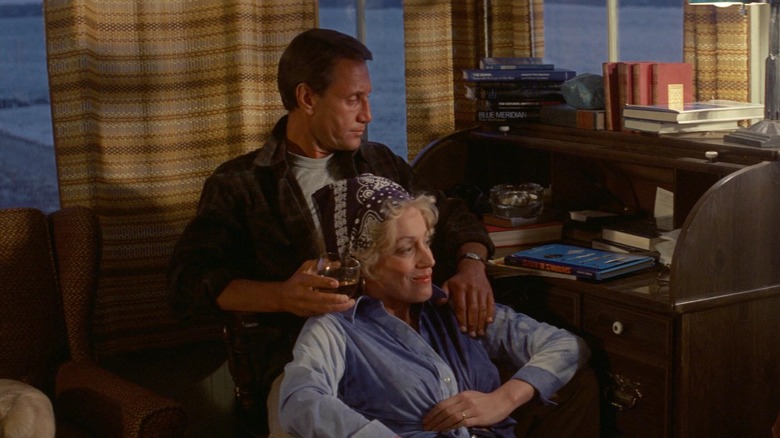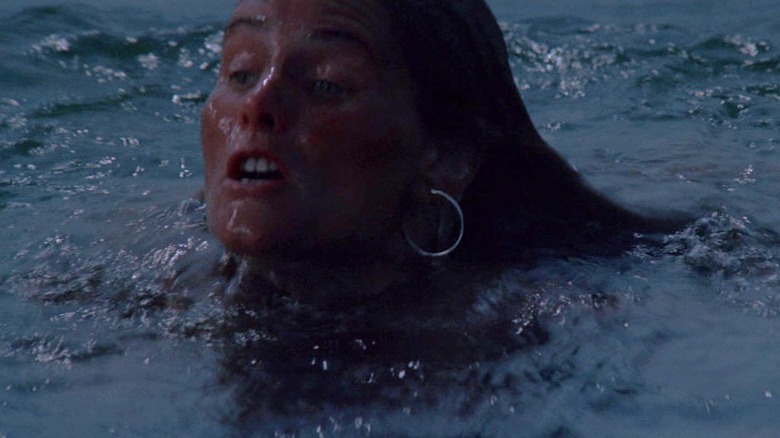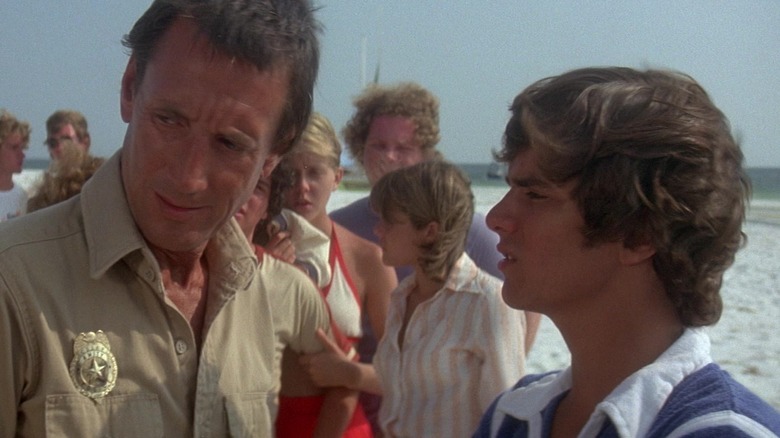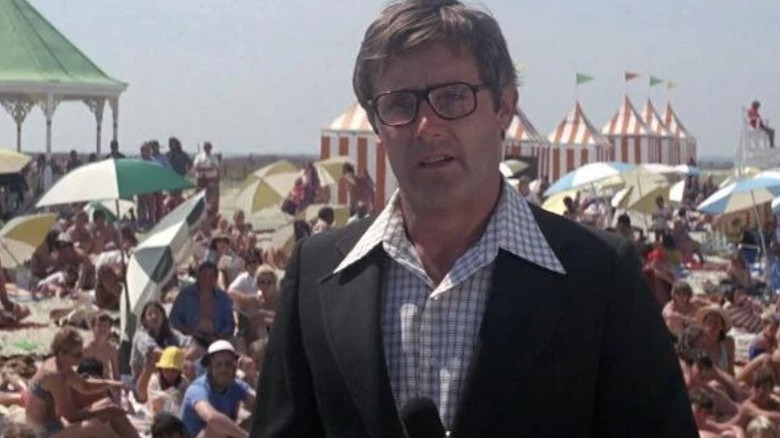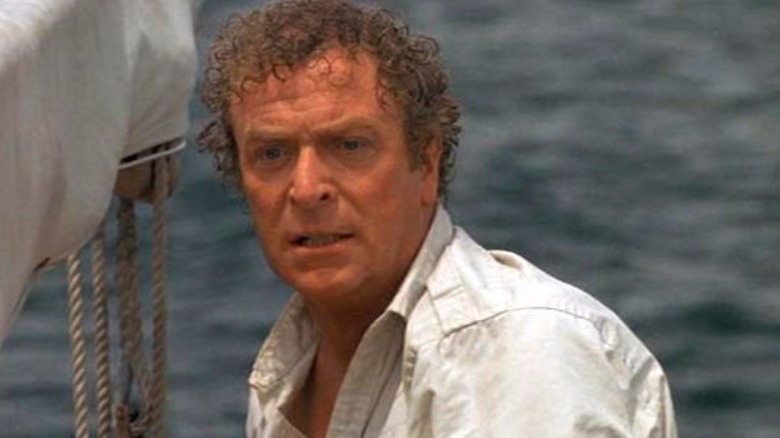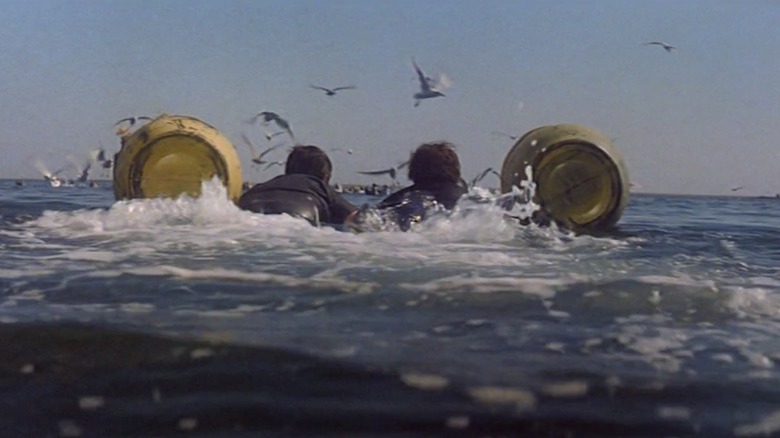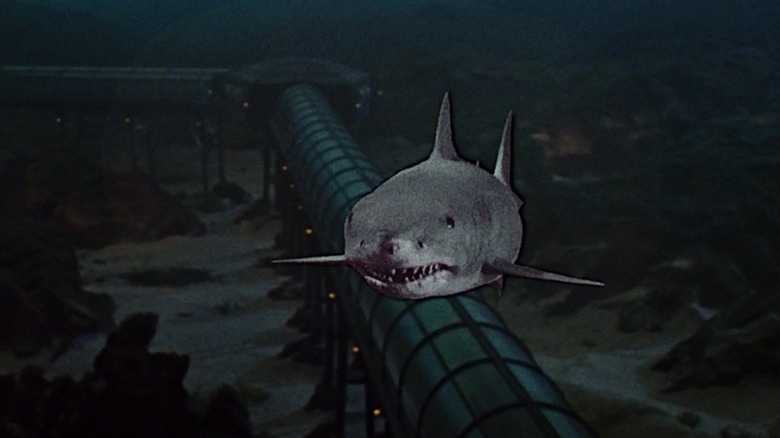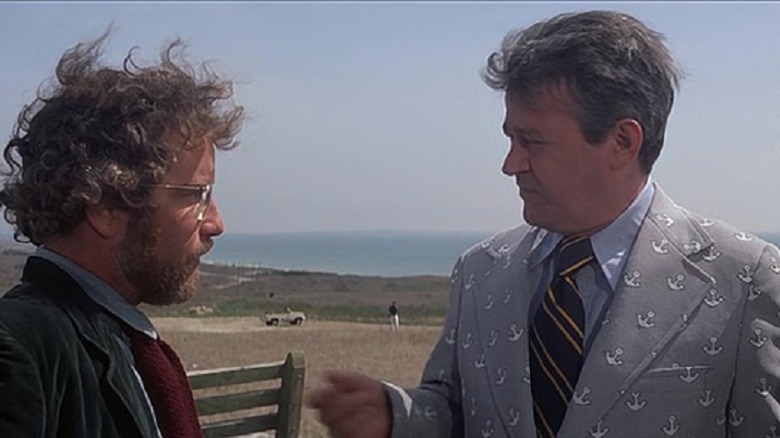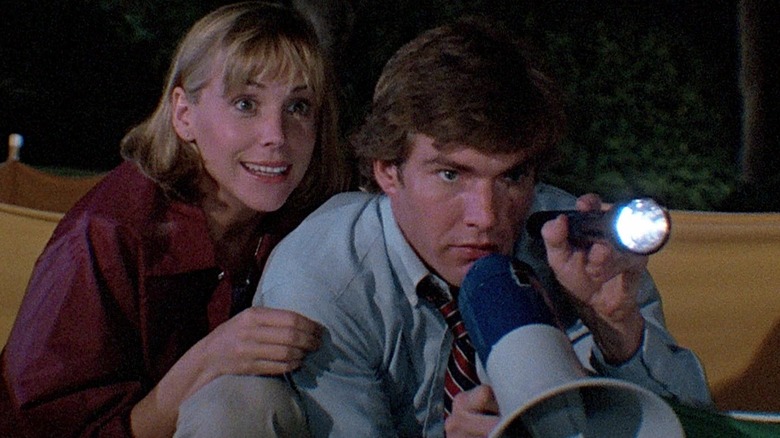Things That Happen In Every Jaws Movie
In 1974, after a few years of freelance writing and struggling to provide for his wife and kids, novelist Peter Benchley's first work of fiction became a bestselling book and remained on the New York Times Bestseller list for 44 weeks (via The Harvard Crimson). That book was "Jaws," a thrilling tale of a great white shark terrorizing the people of the fictional East Coast seaside town called Amity.
Just one year later, director Steven Spielberg — who'd made only one feature-length film prior — acquired the movie rights to "Jaws" and turned it into the first-ever summer blockbuster, changing the face of cinema forever (via IndieWire). Benchley would write more books about the ocean after this — and later become involved in marine conservation (via NPR) — while Spielberg remains one of the most prolific and revered directors in the history of Hollywood.
At the heart of "Jaws" are the protagonists — the Brody family — who spend four movies fighting against the sharks. The sequels are not as acclaimed as the original — with each title flopping critically and commercially. Regardless of diminishing quality, every installment has its endearing moments that make for fun watches. However, with a story that's often regurgitated on-screen, the "Jaws" franchise isn't immune to keeping things consistent. Let's take a look at some of the things that happen in every "Jaws" movie.
A killer great white shark
It wouldn't be a "Jaws" film without a murderous great white shark unleashing havoc on the Brody family — whether that's in Amity, Florida, or the Bahamas. Author Peter Benchley's inspiration for writing "Jaws" came from a real shark attack — when New Jersey residents "engaged in active warfare" with a great white that killed four people in 1916 (via Business Insider). The former director of the Florida Shark Research Program, George Burgess, said that the New Jersey attacks and the events depicted in "Jaws" are rare occurrences, but that "Animal populations, much like humans, sometimes have deranged individuals."
In a way that would be highly unlikely to happen in real life, all four "Jaws" movies feature a shark as the villain in some capacity. The one with the most personality, however, is "Bruce" from the first film — whom Steven Spielberg famously named after his lawyer (via Today).
As integral as the Brody family is to the franchise, it was "Bruce" who jump-started a newfound fear of deep water and the mysterious animals that inhabit it — particularly sharks (via CBS News). The sharks of "Jaws" are so embedded into popular culture that references to them appear everywhere, from Stephen King's "It" to episodes of "Family Guy."
Death by explosion or electrocution
There are many — including a certain Quentin Tarantino (via CinemaBlend) — who believe that "Jaws" is the greatest movie ever made. From the opening notes of John Williams' unforgettable score to the explosive final scenes, it is a story that conjures immediate terror — in part due to its proximity to an unlikely (but still possible) real-world threat. The fear of the ocean — especially the immensity of how undiscovered it was at the time — rang true to many, and "Jaws" only confirmed these concerns.
After a tumultuous duel on the high seas with the shark, it is left to the heroic police chief Martin Brody (Roy Scheider), to destroy the shark. In a last-ditch effort, Brody manages to get a scuba tank into the shark's mouth and fires the eye-of-the-needle shot to blow the shark to smithereens. While this was the perfect end to this chapter, the world wasn't done with the "Jaws" franchise yet. In the following three sequels, new sharks emerge and threaten the safety of the Brody family — and so the cycle must be repeated.
The ending of "Jaws 2" takes a lot of cues from the original, lining Brody up again to take down the shark — this time by electrocution. The endings of "Jaws 3-D" and "Jaws: The Revenge" see the pattern continue, with the shark's demise happening by a grenade explosion and impalement respectively. In a way that defies all logic, but at least remains consistent with the rest of the series, "Jaws: The Revenge" sees the shark also explode after it is impaled. It doesn't make a lick of sense, but neither does most of this film.
The Brody family are the protagonists
Though the shark is an integral part, the story of "Jaws" is so compelling because of the human characters — namely the Brody family, who remain a constant throughout the series. After moving to Amity, patriarch Martin Brody is forced to face his fear of the ocean and square off with a killer shark — not once, but twice. As Brody's children become more prominent in the sequels, it becomes much less a story about a wild animal wreaking havoc and much more a generational tale of survival, grief, and trauma.
Each Brody family member — except for youngest son Sean — is given a turn as the main protagonist in a film. In "Jaws" and "Jaws 2" it is down to Martin Brody to save the day, but in "Jaws 3-D," Michael (now played by Dennis Quaid) gets his turn when a shark makes their way into the aquarium he works in. After the third movie's plot is retconned in "Jaws: The Revenge," Martin's wife Ellen (Lorraine Gary) takes center stage, as she believes she is being hunted by a great white shark.
The familiarity of having the Brody family always in the spotlight helps create a good continuity in the franchise, even though the events of "Jaws 3-D" are largely disregarded in the overarching story. While Michael Brody never quite lived up to the importance of Martin, the actors who played him — Chris Rebello, Mark Gruner, Quaid, and Lance Guest — all brought admirable depth to a character often trapped underneath the legacy of his father.
Lorraine Gary as Ellen Brody
The only actor to appear in more than two "Jaws" films is Lorraine Gary, who plays Ellen Brody in "Jaws," "Jaws 2," and "Jaws: The Revenge." Gary brought a unique compassion to the role, perfectly portraying a protective mother concerned about the safety of her husband and children amid a catastrophic event in the community. She was often the unsung emotional backbone of each "Jaws" film, and finally got her time in the spotlight in "Jaws: The Revenge."
While she makes an impact in the limited time she does have, Gary doesn't have much screen time in the first two "Jaws" movies, and her prominence in the plot only lasts as long as the conflict remains on land. However, in "Jaws: The Revenge," it is her story to tell. For all its faults, the final installment plays well to Gary's strengths in the way it dips into soap opera melodrama territory, and Ellen's relationship with Hoagie (Michael Caine) lets the character do some much-needed healing.
"Jaws: The Revenge" finds Ellen now widowed after Brody died from a heart attack. Plagued by nightmares, she begins to believe a great white shark is stalking her family — something that is vindicated when the killer fish murders her youngest son, Sean (Mitchell Anderson). Gary's performance in this film is personal and enigmatic of a supporting character getting her swan song.
At least one character dies at the beginning of each film
The original "Jaws" features one of the most recognizable opening sequences in film. When Chrissie Watkins (Susan Backlinie) goes for a drunken skinny dip just off the coast of Amity Island, she is viciously attacked by an unknown creature lurking beneath her. It's a moment that sets the tone for the rest of the movie, and the discovery of her remains on the beach the next day is what causes the town to spiral into panic.
Like many popular slasher films such as "Scream" and "A Nightmare on Elm Street," the first kill in "Jaws" is the most legendary. While subsequent deaths happen, Chrissie's demise is the one that still lingers with audiences. The "Jaws" franchise would continue to capitalize on this with its later installments, with "Jaws 2" opening with two scuba divers getting ravaged by a great white shark as they are taking pictures of what remains of Quint's boat, the Orca.
In "Jaws 3-D," first-time director Joe Alves — who was also the production designer for "Jaws" and "Jaws 2" — waited 14 minutes for the first kill, when a SeaWorld mechanic gets eaten by a shark that made its way into the park. "Jaws: The Revenge" takes the blueprint of "Jaws" and "Jaws 2" and ramps it up a notch by making Sean Brody the first victim of a shark that later stalks the Brody family. You can't have a slasher movie without an introductory kill, and this was an idea that remained consistent across the "Jaws" franchise.
One of the Brodys is always in danger
It wouldn't be a "Jaws" film if someone from the Brody family wasn't in danger. While the first film sees Chief Brody spending much of the runtime chasing down the shark, the first half of the film also places the Brody kids uncomfortably close to danger. When Alex Kintner (Jeffrey Voorhees) is killed, Michael and his friends are just a stone's throw away from him, and he is even closer to becoming shark bait when the killer beast ends up in "the pond" where Michael is playing with his new boat.
In "Jaws 2," Michael is in more danger than his father was, as he and his friends' boats capsize and are subsequently hunted by a different great white to the one that terrorized Amity years before. When Mark Gruner is replaced by Dennis Quaid in 1983 for "Jaws 3-D," Michael is shown as an adult who must assume the hero role and save SeaWorld from a shark attack.
In "Jaws: The Revenge" the shark finally takes a Brody victim, killing the youngest son Sean. This prompts Ellen to take matters into her own hands, while Michael is relegated to a supporting role. Even though the Brody family usually come out on top, there are enough moments of grave danger for them that it's surprising any of them manage to make it out of the franchise alive.
Elements from Peter Benchley's novel
As is the case with most book adaptations, there are far more layers in the source material, and it wasn't possible for Steven Spielberg to translate all of that onto the silver screen. However, there are still elements of Peter Benchley's novel that appear throughout the franchise.
In the book, Benchley explored the Brody family dynamic in a bit more detail, as well as getting into adultery, town hysteria, corrupt politics, and mortality. Many of these subplots didn't make it into "Jaws," perhaps most notably the fact that Brody's wife Ellen had an affair with Hooper. In the book, Ellen also has a great working relationship with Mayor Larry Vaughn — something that is hinted at in "Jaws 2" given Ellen's prominent role in the community — but on the whole Mayor Vaughn is given a much more antagonistic arc in the films.
What remained from Benchley's work, however, was the basic premise of man versus beast — an idea that all the installments share. The centrality of the Brody family is a constant as well. Although Benchley's version of Ellen and Brody are on the verge of a marriage crisis, in the movies their companionship is strong. Without Benchley's novel, the films simply wouldn't exist so it is perhaps fitting that he cements this legacy and appears briefly in "Jaws" as a local news journalist.
Oscar and Golden Globe nominees and winners
Since the release of "Jaws," Steven Spielberg has worked with some of the greatest actors of all-time in some of the most acclaimed movies to ever come out of Hollywood. The prolific director himself has taken home three Academy Awards for "Schindler's List" and "Saving Private Ryan."
The blockbuster franchise of "Jaws" contains numerous award-winning actors. In the original film, future Academy Award winner Richard Dreyfuss played marine biologist Matt Hooper. Playing Brody in "Jaws" and "Jaws 2", the main protagonist, was Roy Scheider — who had already received one nomination for "The French Connection," and would later be nominated again for "All That Jazz." Rounding out the original film's trio was Robert Shaw as Quint who was Oscar-nominated for his portrayal of Henry VIII in "A Man for All Seasons."
Later in the franchise, more award winners and nominees would enter the fold. In "Jaws 3-D," Academy Award winner Louis Gossett Jr. and future Golden Globe nominee Dennis Quaid took their turn. Four years later, in "Jaws: The Revenge," two-time Academy Award winner Michael Caine injects life into the floundering final chapter — in the same year he would take home the best supporting actor statue for his performance in "Hannah and Her Sisters."
Short-lived happily-ever-after endings
The most frustrating part of the "Jaws" franchise is the unbelievable idea that there are multiple killer great white sharks in the world that want to specifically target the Brody family. After Chief Brody blew up the shark at the end of the original film, there's euphoria in the bliss that comes when he and Hooper paddle their way back to Amity Beach. Happily-ever-after ... or so you would think.
Whenever someone in the Brody family saves the day, their "happily-ever-after" is completely disregarded when the next film rolls around, and the characters are forced to once again tackle the trauma head-on. A new shark comes around in "Jaws 2," and that process repeats in "Jaws 3-D" and "Jaws: The Revenge." No explosion or electrocution seems to be enough to let the Brody family finally have some peace — something that is particularly annoying as the series progresses.
It is no wonder the films start to feel formulaic — and dramatically decline in quality — the further you get, with "Jaws: The Revenge" being particularly reviled. It also flopped at the box office, making only a quarter of what "Jaws 2" raked in. While the legacy of the original "Jaws" has never been tarnished by its subsequent sequels, constantly undoing each film's happy ending does begin to feel repetitive. And with the sequels — particularly "Jaws 3-D" and "Jaws: The Revenge" — being such big box office flops, it begs the question: Why did "Jaws" movies keep getting greenlit?
Awful looking sharks
Despite being such a landmark film in Hollywood history, "Jaws" has never been immune to jokes about how "fake" the animatronic shark looked in the film — immortalized in a particularly great gag from "Back to the Future Part 2." The shark famously had a lot of mechanical issues, which limited the amount of times it appears on-screen. That circumstance helped the end result, however, as the lack of visibility increased the fear and tension happening throughout the movie.
Audiences would go on to miss the animatronic sharks of "Jaws" and "Jaws 2," however, as the attempt to make a three-dimensional shark feature in "Jaws 3-D" was a comical misfire. This technology has come a long way since then, but the on-screen appearances of the shark in "Jaws 3-D" are laughable and cringeworthy.
In "Jaws: The Revenge," the great white shark is a slight improvement on "Jaws 3-D," but it gained a certain notoriety for roaring before it gets killed by Ellen. The biggest problem here is one small detail overlooked by filmmakers: Sharks can't roar. According to Atlas Obscura, there are no organs in a shark's body that are capable of making audible sounds. Giving the shark in "Jaws: The Revenge" a voice only adds to the cartoon-like quality of it — something emphasized even further as the roar was reportedly the same sound effect from a 1946 "Tom and Jerry" cartoon (via The Daily Jaws).
Townspeople who make bad choices
Almost every minor character in the "Jaws" franchise — especially in the first two films — makes some of the worst decisions you've ever seen. This plot point was a big part of "Jaws" in 1975, with a whole horde of townspeople in denial that a shark could exist. This blindness to the truth is epitomized by Mayor Vaughn (Murray Hamilton), who fights to keep the beaches open, leading to unnecessary deaths.
Throughout the first half of "Jaws," we also see various ill-equipped fishermen heading out to sea to try and catch the shark for themselves. Two men even decide to head out in the dead of night to try their luck, throwing their holiday roast into the water before the shark destroys the dock — and presumably the roast — leaving them barely making it out alive.
In "Jaws 2," Brody is voted out as police chief after presenting irrefutable evidence to the town council — further proving that he is far too good for the town he serves and that they really should start listening to him. The poor decision-making only continues in the franchise, with an ill-advised break-in at the SeaWorld park in "Jaws 3-D" resulting in two deaths. Finally, "Jaws: The Revenge" ups the stupid stakes with the character Jake (Mario Van Peebles) devising a foolproof scheme to catch the shark by luring it straight at him — which results in him barely making it out alive.
A member of the Brody family causing widespread panic
Is it a "Jaws" movie if a member of the Brody family isn't making a huge scene and causing widespread panic? Whether it's Martin, Ellen, or Michael, someone in the Brody lineage is always hollering about sharks. To top it off very rarely does anyone else ever believe or buy into what the Brodys are saying.
In the first film, Mayor Vaughn wants to keep the beaches open — going against Brody's warnings — because he is so concerned about losing money. After finding Chrissie's remains on the beach, Brody goes through the wringer trying to get the rest of the town to abide cautiously, but his concerns are vindicated when the shark shows up for all to see on the Fourth of July weekend. In "Jaws 2," Michael and his friends cause a lot of panic when they get stranded and hunted by the killer shark, while Ellen's proclamations about a vengeful shark stalking her are taken lightly in "Jaws: The Revenge."
If you're going to take a lesson away from the "Jaws" franchise, it is perhaps that you should listen to the Brody family. Chief Brody may be over-cautious in the beginning, but it isn't without justification, and a lot of deaths could've been prevented if the townspeople had listened to what he had to say.
